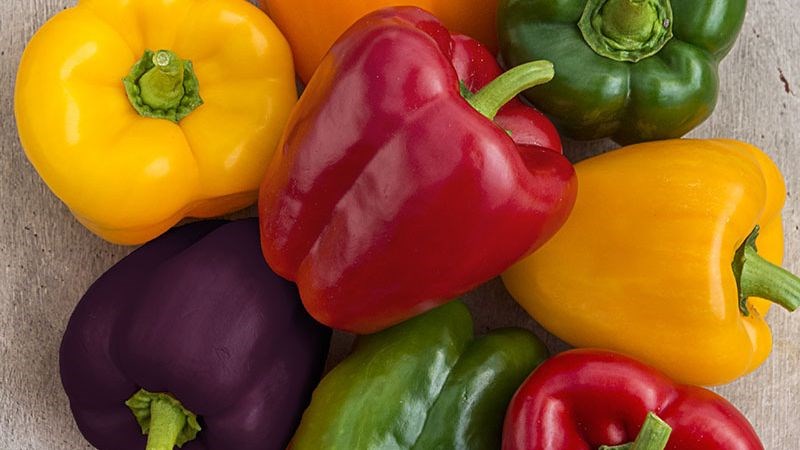Bell peppers are a familiar food in the cuisine of many countries around the world, containing many nutritional values and eye-catching colors. So what are the effects of eating bell peppers? Let’s find out through the following article!
1 What is a bell pepper? Nutritional value in bell peppers
Bell peppers are a sweet, non-spicy pepper with large, thick, and crispy skin. They are often used in many dishes, from desserts, grilled dishes, stir-fried dishes to salads.
Bell peppers come in a variety of colors such as red, yellow, green, orange… Each color of bell pepper has a different flavor and nutritional properties.
The nutritional value of bell peppers depends on the variety of plant, care and storage conditions. In general, it can be estimated that 100g of bell peppers provides about 20 calories and many other nutritional components such as:
0.86g of protein.
0.17g of fat.
4.64g of carbohydrates.
1.7g of fiber.
2.4g of sugar.
10mg of calcium.
0.34mg of iron.
10mg of magnesium.
20mg of phosphorus.
175mg potassium.
3mg sodium.
0.13mg zinc.
0.122mg manganese.
80.4mg vitamin C.
0.907mg vitamin B.
595µg vitamin A.
0.37mg vitamin E.

Bell peppers bring many health benefits to users.
2 Benefits of Bell Peppers
Improves Vision
Green bell peppers contain lutein, a carotenoid nutrient that is a precursor to vitamin A. Lutein helps protect eye cells from damage caused by light, especially UV rays.
In addition, a study has shown that lutein can reduce the risk of age-related macular degeneration (AMD). AMD causes vision loss and is common in older people.
Good for the heart
Red bell peppers are rich in the antioxidant lycopene, which helps protect the heart. Meanwhile, green bell peppers are rich in fiber, which can reduce the absorption of cholesterol from food and support the process of eliminating excess cholesterol in the body, maintaining stable cardiovascular health.
In addition, vitamin B6 and folic acid in bell peppers will help reduce homocysteine levels in the blood, reducing the risk of heart disease. Vitamins E and C will help eliminate free radicals that cause oxidative damage to cells. (See more folic acid products that support increased blood production, help supplement iron for the body, support red blood cell production, help reduce the risk of iron deficiency anemia, and enhance resistance).
Bell peppers are also a food source rich in potassium, a mineral that is beneficial for cardiovascular health. Potassium helps balance the amount of water in the body and regulate blood pressure, while supporting muscle and nerve function.

Bell peppers are rich in antioxidants that protect the heart from harmful agents.
Support blood sugar stabilization
Polyphenol is an antioxidant in bell peppers that can reduce blood sugar levels, helping to stabilize blood sugar. In addition, bell peppers are rich in fiber, vitamins and minerals, low in sugar, so they can limit the sudden increase in blood sugar after eating.
Helps prevent anemia
Bell peppers contain a significant amount of iron that supports the process of hemoglobin production, helping the body improve iron deficiency anemia. In addition, bell peppers also have a strong vitamin C and antioxidant content, which can enhance the body’s ability to absorb iron.
Aids digestion
Fiber is a type of carbohydrate that is not digested by the stomach and intestines. Adding fiber-rich foods such as bell peppers helps create favorable conditions for beneficial intestinal bacteria to grow, balance the intestinal microflora, support intestinal activity and prevent constipation.
Some studies also show that increasing fiber intake can help the body fight digestive diseases such as colon cancer, colitis.
Weight Control Aids
Bell peppers are low in calories and high in fiber. This means you can enjoy them without worrying about excess calories.
Fiber is not digested, so it can help you feel fuller for longer and reduce cravings. This will help keep your weight in check.
Preventing chronic diseases
Bell peppers are rich in antioxidants, especially vitamin C, vitamin E, beta-carotene, polyphenols, lutein, quercetin and capsanthin. These substances have antibacterial and anti-inflammatory effects, slow down cell damage and reduce the risk of chronic diseases such as diabetes, cardiovascular disease and cancer.
Prevent Alzheimer’s disease
The active ingredients in bell peppers can inhibit the enzyme that releases amyloid protein, which attaches to nerve fibers, affecting nerve activity leading to Alzheimer’s disease.
In addition, bell peppers also provide a rich amount of vitamin B6. They participate in the production of chemical compounds in the brain including neurotransmitters such as serotonin, dopamine and GABA, which play an important role in the transmission of information between brain cells.
Cancer Prevention Support
Red bell peppers are rich in beta-cryptoxanthin, a precursor of vitamin A. Some studies show that foods rich in beta-cryptoxanthin can help reduce the risk of lung cancer, colon cancer, etc. In addition, beta-cryptoxanthin is also an antioxidant, helping to protect cells from changes that can lead to cancer.
Strengthening resistance, preventing colds
Bell peppers are rich in vitamin C, which helps strengthen resistance and support the function of immune cells. Thanks to that, the body can fight pathogens.
In addition, the natural antibacterial and antiviral substances in bell peppers also help reduce the risk of infections and colds. In addition, antioxidants also play an important role in soothing the symptoms of inflammatory reactions.
Strengthens Bones and Joints
A medium bell pepper provides about 6% of the body’s daily manganese requirement. Manganese, along with zinc and copper, are important trace elements for bone health.
Bell peppers also provide many other vitamins to the body. In particular, vitamin C and vitamin K have anti-inflammatory properties, helping to effectively prevent osteoporosis.
Good for skin and hair
The natural vitamin C in bell peppers plays an important role in collagen production, keeping the skin youthful and healthy. A lack of vitamin C can cause dry and wrinkled skin. In addition, vitamin C also helps provide antioxidant properties, protecting the skin from damage.
Eating bell peppers also helps improve circulation, transporting nutrients throughout the body. This ensures healthy skin and hair.
3 Is it good to eat a lot of bell peppers?
Although bell peppers are a source of many nutrients that are beneficial to health, eating too many bell peppers without supplementing other foods can lead to nutritional deficiencies.
In addition, eating too many bell peppers can also cause some side effects such as digestive disorders (abdominal pain, bloating, nausea, diarrhea, …) or allergic reactions (red rash, hives, …).
Therefore, to ensure a healthy body, you need to combine bell peppers in a healthy, diverse and nutritious diet.
4 Things to Consider When Eating Bell Peppers
Which color bell pepper is best?
Red, orange, and yellow bell peppers are the sweetest, decreasing in sweetness from red to yellow. They are popular choices and are often more expensive than green bell peppers.
Green, white, and purple bell peppers are not as sweet as other colors, but have a refreshing flavor with a hint of bitterness. Green bell peppers are the least bitter, and purple is the most bitter.
However, the choice of bell pepper color is a matter of personal preference and does not affect their nutritional value too much.

The color of bell peppers does not affect their nutritional value much.
Who should not eat a lot of bell peppers?
Some special groups should not eat bell peppers, including:
People with sensitive digestive systems or intestinal problems.
Patients with hemorrhoids, stomach ulcers, esophagitis.
People at risk of osteoporosis.
People with vision problems.
People who are allergic to active ingredients in bell peppers.
People with fever, high blood pressure or tuberculosis.
Notes when choosing and preserving bell peppers
When choosing to buy bell peppers, you need to note:
Choose fresh bell peppers with bright colors, juicy, smooth skin and fresh green stems.
Avoid choosing bell peppers with soft, cracked, wrinkled skin or brown spots.
You should choose female bell peppers because they are sweeter and less bitter than male bell peppers.
Tips for choosing female bell peppers: Male bell peppers have three small grooves at the bottom, shaped like a fan, while female bell peppers have four small grooves at the bottom, shaped like a cross. Female bell peppers are sweeter and less bitter than male bell peppers.
When preserving bell peppers, you need to note:
Whole bell peppers will stay fresh for about 1 week in the refrigerator.
Once washed and cut, bell peppers will quickly spoil and you need to use them within a few days.
Notes on eating bell peppers
The following notes will help you eat bell peppers more reasonably:
Dosage: If you like bell peppers, you can eat them every day or even in every meal. However, you should only eat them in moderation, the recommended amount is about 100g equivalent to half a bell pepper per day.
Can eat bell peppers raw: They are delicious when combined with meat, spinach or can be easily added to salads.
What foods are incompatible with bell peppers?
Some foods, when eaten with bell peppers, have chemical interactions that reduce each other’s effects, such as:
Sunflower seeds: Iron in bell peppers meets vitamin E in sunflower seeds, which will hinder the absorption of vitamin E.
Cucumbers: Enzymes in parsley can oxidize vitamin C in bell peppers, reducing nutritional value.
Parsley: Vitamin-decomposing enzymes in cucumbers can decompose vitamins in bell peppers, significantly reducing nutritional concentration.
Alcohol: This combination can create compounds that are harmful to the body and can increase the risk of cancer.
In short, bell peppers are low in calories and fat but rich in fiber, vitamins and minerals. These are all valuable nutrients for the body. Hopefully the information in the above article can help you understand more about the beneficial effects of bell peppers!





